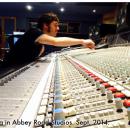Hace poco me compré un pack de plugins de fabfilter (enamorado me tienen), y he visto que en el Pro-DS y el Pro-L hay un parámetro que no entiendo, el lookahead, que se mide en ms. ¿En qué consiste?
¿En qué consiste el ''lookahead''?

OFERTAS Ver todas
-
-13%Kawai ES-60
-
-20%Moog Messenger
-
-13%Steinberg UR24C

Haciendo un poco de memoria, pues no encuentro dónde comentamos esto hace poco... ah, sí ya por aquí, el compañero A800MKIII lo comenta: https://www.hispasonic.com/foros/mejor-limitador-es/455882/pagina3
Es un mecanismo que utilizan los limitadores modernos para adelantarse a la señal y así limitar de forma más transparente, esto dicho de forma un poco burda.
Es un mecanismo que utilizan los limitadores modernos para adelantarse a la señal y así limitar de forma más transparente, esto dicho de forma un poco burda.

He encontrado esta explicación en el foro. Espero que te sirva.
https://www.hispasonic.com/foros/comparativa-limitadores/290174/pagina8#post2306262
https://www.hispasonic.com/foros/comparativa-limitadores/290174/pagina8#post2306262


Esto es lo que dice Fabfilter:
"Lookahead
The Lookahead knob sets the look-ahead time for the initial 'transient' stage. This allows the limiter to examine the incoming audio
in advance and predict the amount of gain reduction needed to meet the requested
output level
. If the look-ahead time is very
short, the limiter doesn't have much time to move to the desired level: this will generally have the effect of preserving transients
better and increasing the apparent loudness, but at the expense of possible distortion. Longer look-ahead times are safer, but less
loud, and transients might appear to get lost in the mix a little more.
Very short look-ahead times (less than 0.1 ms) will approximate 'hard clipping', introducing distortion and aliasing. This causes
inter-sample peaks which can cause further distortion later on. To reduce aliasing and inter-sample peaks, we advice to use
oversampling. Also, turn on ISP metering to visualize the inter-sample peaks generated. This enables you to adjust the output level accordingly"
"Lookahead
The Lookahead knob sets the look-ahead time for the initial 'transient' stage. This allows the limiter to examine the incoming audio
in advance and predict the amount of gain reduction needed to meet the requested
output level
. If the look-ahead time is very
short, the limiter doesn't have much time to move to the desired level: this will generally have the effect of preserving transients
better and increasing the apparent loudness, but at the expense of possible distortion. Longer look-ahead times are safer, but less
loud, and transients might appear to get lost in the mix a little more.
Very short look-ahead times (less than 0.1 ms) will approximate 'hard clipping', introducing distortion and aliasing. This causes
inter-sample peaks which can cause further distortion later on. To reduce aliasing and inter-sample peaks, we advice to use
oversampling. Also, turn on ISP metering to visualize the inter-sample peaks generated. This enables you to adjust the output level accordingly"
Nuevo post
Regístrate o identifícate para poder postear en este hilo






